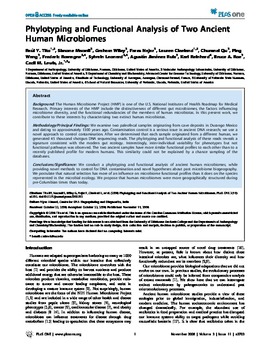| dc.contributor.author | Raúl Y. Tito | en_US |
| dc.contributor.author | Simone Macmil | en_US |
| dc.contributor.author | Graham Wiley | en_US |
| dc.contributor.author | Fares Najar | en_US |
| dc.contributor.author | Lauren Cleeland | en_US |
| dc.contributor.author | Chunmei Qu | en_US |
| dc.contributor.author | Ping Wang | en_US |
| dc.contributor.author | Frederic Romagne | en_US |
| dc.contributor.author | Sylvain Leonard | en_US |
| dc.contributor.author | Agustín Jiménez Ruiz | en_US |
| dc.contributor.author | Karl Reinhard | en_US |
| dc.contributor.author | Bruce A. Roe | en_US |
| dc.contributor.author | Cecil M. Lewis Jr. | en_US |
| dc.date.accessioned | 2015-01-23T17:17:28Z | |
| dc.date.accessioned | 2016-03-30T15:35:49Z | |
| dc.date.available | 2015-01-23T17:17:28Z | |
| dc.date.available | 2016-03-30T15:35:49Z | |
| dc.date.issued | 2008-11-11 | en_US |
| dc.identifier.citation | Tito RY, Macmil S, Wiley G, Najar F, Cleeland L, et al. (2008) Phylotyping and Functional Analysis of Two Ancient Human Microbiomes. PLoS ONE 3(11): e3703. doi:10.1371/journal.pone.0003703 | en_US |
| dc.identifier.uri | https://hdl.handle.net/11244/14060 | |
| dc.description | We appreciate comments received by anonymous reviewers at earlier stages of this study. | en_US |
| dc.description | Conceived and designed the experiments: RT SM GW FZN BAR CMLJ. Performed the experiments: RT SM GW LC CQ PW CMLJ. Analyzed the data: RT FZN SL FR CMLJ. Contributed reagents/materials/analysis tools: FAJ KR BAR CMLJ. Wrote the paper: RT CMLJ. | en_US |
| dc.description.abstract | BackgroundThe Human Microbiome Project (HMP) is one of the U.S. National Institutes of Health Roadmap for Medical Research. Primary interests of the HMP include the distinctiveness of different gut microbiomes, the factors influencing microbiome diversity, and the functional redundancies of the members of human microbiotas. In this present work, we contribute to these interests by characterizing two extinct human microbiotas.Methodology/Principal FindingsWe examine two paleofecal samples originating from cave deposits in Durango Mexico and dating to approximately 1300 years ago. Contamination control is a serious issue in ancient DNA research; we use a novel approach to control contamination. After we determined that each sample originated from a different human, we generated 45 thousand shotgun DNA sequencing reads. The phylotyping and functional analysis of these reads reveals a signature consistent with the modern gut ecology. Interestingly, inter-individual variability for phenotypes but not functional pathways was observed. The two ancient samples have more similar functional profiles to each other than to a recently published profile for modern humans. This similarity could not be explained by a chance sampling of the databases.Conclusions/SignificanceWe conduct a phylotyping and functional analysis of ancient human microbiomes, while providing novel methods to control for DNA contamination and novel hypotheses about past microbiome biogeography. We postulate that natural selection has more of an influence on microbiome functional profiles than it does on the species represented in the microbial ecology. We propose that human microbiomes were more geographically structured during pre-Columbian times than today. | en_US |
| dc.language.iso | en_US | en_US |
| dc.publisher | PLos One | en_US |
| dc.relation.ispartofseries | PLoS ONE 3(11):e3703 | en_US |
| dc.relation.uri | http://www.plosone.org/article/info%3Adoi%2F10.1371%2Fjournal.pone.0003703 | en_US |
| dc.rights | Attribution 3.0 United States | en_US |
| dc.rights.uri | https://creativecommons.org/licenses/by/3.0/us/ | en_US |
| dc.subject | PLOS | en_US |
| dc.subject | Public Library of Science | en_US |
| dc.subject | Open Access | en_US |
| dc.subject | Open-Access | en_US |
| dc.subject | Science | en_US |
| dc.subject | Medicine | en_US |
| dc.subject | Biology | en_US |
| dc.subject | Research | en_US |
| dc.subject | Peer-review | en_US |
| dc.subject | Inclusive | en_US |
| dc.subject | Interdisciplinary | en_US |
| dc.subject | Ante-disciplinary | en_US |
| dc.subject | Physics | en_US |
| dc.subject | Chemistry | en_US |
| dc.subject | Engineering | en_US |
| dc.title | Phylotyping and Functional Analysis of Two Ancient Human Microbiomes | en_US |
| dc.type | Research Article | en_US |
| dc.description.peerreview | Yes | en_US |
| dc.description.peerreviewnotes | http://www.plosone.org/static/editorial#peer | en_US |
| dc.identifier.doi | 10.1371/journal.pone.0003703 | en_US |
| dc.rights.requestable | false | en_US |

